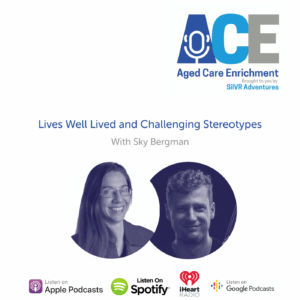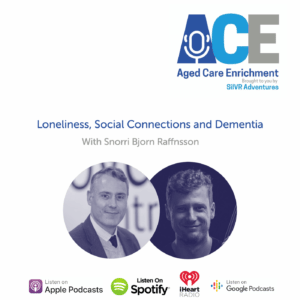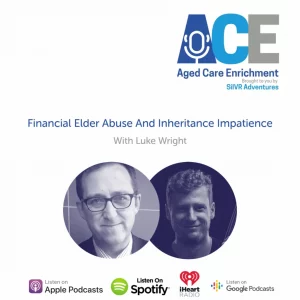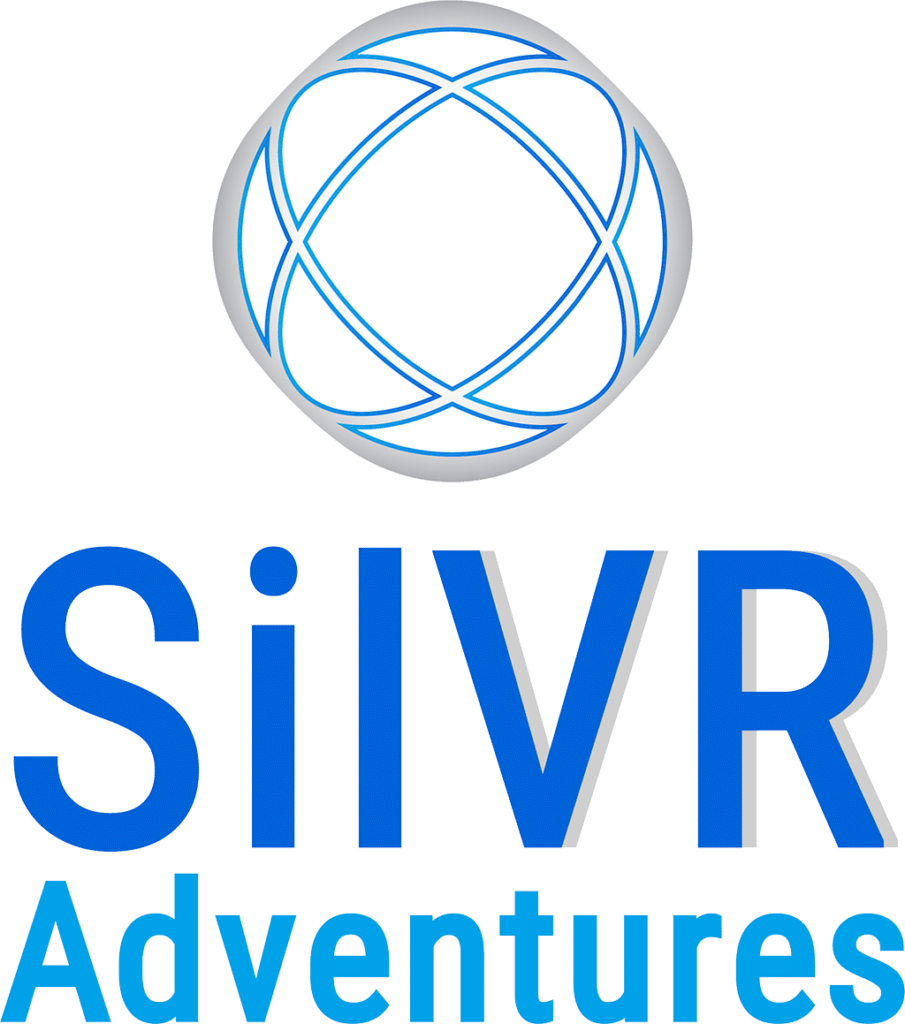Susan Ryan is the Senior Director of an American not for profit called the Green House Project, which proposes an alternative model to traditional care facilities – one that looks and feels like like a real home. The Green House Project’s work is quite well known and influential within aged care management circles for building a functional and financially viable aged care model for small numbers of residents.
This episode is all about understanding the ethos behind this model and why it’s goal to de-institutionalise aged care is a priority. Susan argues that one fundamental reason to rethink the structure of care is that currently it is disrespectful and inhumane to the care recipieints.
Similar to our conversation with Neha Sinha from India’s Epoch Elder Care, Susan talks about how fostering feelings of home, family and belonging is crucial to supporting care recipients in a humane way.
There’s also some mention of the importance of dignity of risk, and that some potentially ‘unsafe’ activities can be the most rewarding for older adults.
Transcript
Ash de Neef: Great, Susan, thank you so much for joining us today on the podcast.
Susan Ryan: I am so pleased to be with you. Thanks so much for having me.
Ash de Neef: What a pleasure for us as well. Can we start with a bit about yourself and what it is that you’re doing at the moment?
Susan Ryan: Sure myself happens to be a nurse. I approach everything I do through the lens. Of a nurse that has spent the bulk of her career in long-term care, home care, as well as those skilled nursing home environments. And honestly, I had my call to action moment as the director of nursing in a nursing home in which I really just.
Well it was at a time when we tied people up to keep them safe, to keep them from falling. And while that was considered best practice, in my heart I just thought there’s no way that this can be right. And so I embarked on a career in home care and it was actually a grant funded program to prevent institutionalization of the elderly. And I really resonated with that thought.
I thought I needed to keep people out of those dreadful places and really try to create systems and structures, education, and screening, to be able to keep people living better lives in their own homes. So that lasted for a good while.
But finally, in 2001, I went back into long-term care with a real desire and a passion to reform, and here’s why. As lovely as home care is, and I still believe it’s lovely. It can be cost prohibitive and socially isolating. And so for me, I thought we’ve got to have those respectable humane environments in which people can live good lives, albeit in a nursing home. But they should still be able to live a dignified and humane experience and have their quality of life met in a nursing home.
So I went back and started working with an organization. I heard about the greenhouse model in 2005, went to visit, and for me it was my two worlds coming together beautifully. I thought that’s home care. It’s a real home. And it’s licensed as skilled nursing. And for me, it was the best of my worlds coming together.
So in 2008, I joined the greenhouse project team and I have been a part of a mission that is out to eradicate institutional models and to really create those humane experiences that I was looking for.
Ash de Neef: Fantastic. And there’s a lot of really great words that I want to tap into here. So can we start with respectful and humane and what are the elements of traditional aged care, residential care that you find that I’m not disrespectful or inhumane.
Susan Ryan: Any time that you have a group of people that is other. Or a group of people that you just, look at their needs as different from our basic human needs. Whenever we have a tendency to warehouse, to put everybody in one place and treat them all similarly, as if they’re not individuals with unique needs. Whenever we just approach care as tasks and not see the person in the task. That to me, that’s not dignified. And that’s not humane.
Because each of us, you are an individual. I’m an individual. We’re living in very different places, different cultures. There are so many things that are unique and different about us. And as we approach an older age and should we be in a community, long-term care community. I want to be known as that individual and to not just be known by what I need from a care approach, but what I need as a person. As an individual to live life and not be just defined by my diagnosis or what my care needs would dictate.
Ash de Neef: Yeah, fantastic.
So you mentioned earlier this word of institutionalized care and trying to move away from that. How are you defining institutionalized care?
Susan Ryan: Think about an institution. I don’t think there’s anything that would make you, or I want to live in an institution. Yet in the US I can tell you that most nursing homes have been modeled after hospitals. Hospitals are great institutions. And we have brought that philosophy into our care approaches and long-term care in nursing homes. And that’s an institutionalized approach.
There are very rigid schedules and protocols. Hospitals weren’t created as places to live. They were created as places to, when you’re sick,you go there to get better. And that’s not what we want for nursing homes, places that we are going to come to live at the end of our life.
And so I think it’s really de-institutionalizing that approach that says, it’s all about what you need by virtue of your diagnosis and what are all the medications you need? What are all the treatments you need? And how do I get you here, there, and everywhere to therapy or whatever that might be.
And it’s a very routinized task focused approach. And to me, that’s part of an institutional frame that we bring to what we do each day.
Ash de Neef: Fantastic. And some of our listeners will be aware of the greenhouse model and the greenhouse project, but can you outline for us, what is the alternative that’s being presented here?
Susan Ryan: We’ve talked a lot about the de-institutionalization. And I would say that starts first in our minds. We have to de-institutionalize our thinking and recognize that we’ve got incredible, and I will speak for myself as a nurse.
I brought a lot of institutional knowledge as a nurse. I was schooled to really know how to be as efficient and effective as possible making decisions that worked well for me and my clinical team and the CNA, certified nursing assistants, and so forth. So it’s really rethinking and de-institutionalizing that thinking.
But let me describe for you what the greenhouse model is. And I’m going to use our core values as the lens, by which to take a look at the greenhouse model. I’ve talked a lot about the philosophical piece, but let me go back to the piece that I think is probably what most people focus on. It’s the part that’s most obvious and that core value is real home. And that is the physical environment that would be de-institutionalized. And I’ll just take you visually, audio wise, into a visit to a greenhouse home.
And a greenhouse home you would look on the outside and you would see a real home, a single family home, and you would bring the doorbell. You’re not going to barge in because it’s a real home and I would not barge into your home without ringing the doorbell first. I wouldn’t barge into any one of my neighbor’s homes without ringing the doorbell first. So it’s the physical environment. It cues you, that’s a real home.
I ring the doorbell. I walk in, it’s an open concept, 10 or 12 private rooms with en suite showers in their private rooms. So we have de-centralized the bathing process. So every room, private room has their own private roll-in shower. That’s dignified. That’s humane, I would say. But the open concept that you will see, we call it the hearth or the heart of the home, and that’s where intentional community can happen.
So think about your own home and what’s there to really draw people together? You’re going to have an open kitchen. You’re going to have a living room and dining room. And that just really to me is emblematic of what a real home would be.
Or do I don’t know about you, but the heart of the home is, if you’re having any entertaining whatsoever. Where do people gather? The kitchen.
Susan Ryan: And so you’ve got the kitchen, that open concept kitchen where aromas would be filling the house. And if I’m living there as a resident, then the smell of bacon cooking in the morning, I might be inclined to want to get out of my bed and come on my own terms to one long dining table. That’s in our dining room and is it’s a family table.
It’s not four top scattered here and there, but it really is saying, how did we take our meals? My meals with my family, my children were gathered around one table. It’s not that some were sitting here and some were sitting here. We ate all together at one table and that’s what staff and the residents living in a greenhouse home would do.
10 or 12 people living there supported by a team. And then the living room, we’ve got a fireplace and that just for me I, with my kids, I love sitting around the fireplace and especially a colder times, and we would just really have those moments of socialization.
There’s typically a den, another kind of private space where family members might want to come, if they’re not wanting to meet with them in the more common areas that a den. It’s kind of a little more private, or they could meet in their own bedroom.
The other thing is an office. And unlike a nurses station, the office is really designed to look like a home office like you or I would have in our own homes.
This is not an institution and this does not look like nursing homes that I might conjure in my mind. But it’s more than that. It’s the philosophical culture that you and I’ve been talking about practically since we started. And that is, the focus is more on who the person is and a whole person approach to deeply know who that person is.
Susan Ryan: And I think everybody talks about person-centered care. And that’s awesome. But we go further and we say it’s relationship rich, person directed living. So think about the differences. We are saying that through deep knowing relationships are at the core of being able to, for a person to direct his or her living experiences.
So it’s not just care that’s centered on the person. But it’s through relationships and knowing who each individual is, how we can enable that person to direct his or her life so they have those experiences.
And last but not least. And I think this is the core value that often gets overlooked and that is we call it empowered staff and to really address the workforce.
And what do we mean by empowered staff? I would say empowered staff is a function of leadership that you can’t have staff empowerment without leaders who know how to offer the support, the education. Everything necessary to equip that staff to be fully empowered, to be in consistent or dedicated relationships with those in the home.
And what I find is that when you’ve got consistent or dedicated teams working with the individuals in that home, there’s real magic that happens. And when they’ve De-institutionalized their thinking, and de-stigmatized how they see people living in those homes.
And they’ve got wise leaders that are equipping them to really be successful in how they operationalize it. There’s real magic that happens. And then you see people that are able to live some really high quality lives.
Ash de Neef: There’s so much great information that I want to unpack and starting with the idea of the universal worker, it’s almost as if they’re a member of the family in the greenhouse home. it’s not just, a myriad of different people coming in to do different things. That’s going to make it feel much more organic, right?
Susan Ryan: I am so glad you brought that up, that it’s like a family. And, I can certainly relate as a mom who was caring for three children and I was cooking. I was providing care. I had a load of laundry in at the same time and I could conceive of it. So I’m so grateful to have you say that because that’s exactly right.
And you just think about what you get to know. I knew what my kids like to eat and what they didn’t like to eat. And similarly, it really supports the other thing that you mentioned that I really liked was they serve like family. They become like family members and you’re right.
And that dining table just says, we’re family. We’re coming around the table to have a meal together. And there’s something really powerful and really beautiful about what happens there. And, during the pandemic, I have heard a lot of people say because we had a blanket ban on the visitation.
And what was really interesting to me was how it was really those deep knowing relationships, they became surrogate family members. And those relationships were so tight and there were some days. It’s not like they’re replacing them.
And with smartphones nowadays a care partner might have noticed a resident who was feeling a bit tearful. She says, “I think we just need to do a FaceTime with your daughter. How would that be?” And so via FaceTime, they were able to get the daughter on. If you have so many different people that are touching that person during the day, that perhaps aren’t the same dedicated staffing that’s coming in and out of that home.
I don’t know that would have happened as lovely as it did when somebody is in that dedicated relationship, they really do function as family members.
Ash de Neef: Yeah. Fantastic. And there’s something else I want to really highlight that you mentioned before when you were talking about relationship-rich personalized living. This idea that care may be one aspect of somebody’s life and maybe one aspect of what’s happening for someone in a day to day situation, but it is not everything.
And to define it as such is problematic. And it’s leading back to that institutionalized model that you mentioned.
Susan Ryan: Absolutely. And that’s, as I said, de-institutionalized, our thinking. When I think about the different mindsets that we bring to the table and what that looks like, and I think that’s part of it. Do you know what is meaningful and purposeful living to each person? And yes, there are care needs that need to be thought about and addressed. But I think more importantly, it really is about what makes the meaningful day for a person.
And once again, it’s not a one size fits all. And that’s why it’s so important to have those relationships, to really tap into who that person is. And as a person who might be living with some cognitive impairment and it may be more challenging to understand who that person is. And what will make for a meaningful day – meaningful life is the name of that core value that we have.
And that means our focus is really helping that person to engage each day in a meaningful and purposeful way, we want philosophically that culture, everything that is done to really speak a meaningful life.
And so that happens through relationships and, we believe pets can be a big part of it. We believe gardening can be a big part of it. It may be cooking Oh, I had some wonderful stories that emerged during the pandemic where they were able to, with appropriate PPE and safety precautions.
It was a, woman who was living with some dementia and she was just feeling a bit frustrated in that life, wasn’t quite the way it was. But the deep knowing told this care partner that this was somebody who was a homemaker who loved to bake, who took great pride in what she did. So what did they do? They baked a cake. And they made a cake that was able to be served to everybody.
And you think about how that impacted that woman’s day to be doing something that was so familiar and so visually reinforcing to her identity. And there was something in that procedural memory bank that she knew what she was doing.
And so that became meaningful life and purposeful living for her.
Ash de Neef: Yeah, that’s great. I guess I have some questions regarding in the case of people who might have declining cognitive abilities, who are living in a greenhouse home and something we’ve talked about a lot on the podcast is deception and how that can factor into many different aged care settings.
Because the setup of a greenhouse home is to replicate a home and it’s not immediately clear that it is a care environment, do you think there is a level of deception here? And if there is that a problem?
Susan Ryan: Yeah. That’s I think a great question. And none of us want to be deceived or be deceptive in our approach. I think home, it’s just where we all want to be. And while it is not that person’s, I’ll call it native home, I do believe that what’s created there. It becomes home. It becomes centering.
And we do a lot of, in our education, to really think about how do we really create home and what does home really mean to us and how do we establish that sense of belonging and that ability to feel connected because that supports our well-being. So it’s not deceiving in my opinion. I think, what it really is doing is tapping into that person’s identity that person’s need to connect that sense of belonging.
That is so important to all of us as human beings and to really determine how do we make that happen for a person. Who might be confused in terms of whereabouts and where am I? And I have this need to go home and they’re in their greenhouse home. So what is that person really trying to say? How is that person’s sense of belonging or connected-ness at the moment being compromised and what might we need to do?
As I mentioned, the care partner who pulled up her phone and said, “Do you to talk to your daughter?” And for her that worked, but what else might it be? And what can we know through those deep knowing relationships that might give us an indication that would help us understand how we can still support her well being and her need to connect and that sense of belonging.
Ash de Neef: Yeah. Fantastic. I think it’s always a tricky one when you’re providing a safe space and you’re providing a place that people want to go to. And in the situation which I mentioned, if somebody isn’t always aware of the fact that this is not their native home to use your words, but they’re comfortable and they’re happy and they’re living fulfilled, enriching lives.
Why would you orient anybody to the change in circumstance for them?
Susan Ryan: It’s interesting way back. I’m old enough to know, or I’ve been a nurse when reality orientation was what we used to do. And we had these signs all over the place. I told you what day it was and what the weather was, what the next holiday was. And whenever somebody just said, “I need to go home.” “No, honey, you’re this your home.”
And of course it’s an institution and you know what that did to just create such anxiety and stress, but to not shy away from having conversations and to be fully present in the moment. And I think, not for the podcast today, there wouldn’t be enough time for me to go through our approaches, but we have a memory care approach.
We call it the best life approach. And it really is designed to around four principles that build upon those core values I talked about, and it really is designed to be able to help that person. We call it meaningful life with best life. It’s a best life approach. And I would say the other thing about what I would say about best life.
I’ll just give you the principles very quickly. It’s about the power of normal and really making sure that we normalize our programs and our environments and all of our interactions to really create age appropriateness in those interactions. And the more there’s a power in normalcy and really seeking to achieve a normal reactions.
And I think, we have this propensity to keep people safe at all costs. That’s why back in the day, I tied people up to keep them from falling. God forbid they would fall on my shift or God forbid they would leave the building. We call that an elopement. And so we did everything we could to control them.
What is that behavior trying to tell me? And how do we really, again, seek to know the person and not shy away from the risk? To recognize risk has an upside and a downside. And how can we really seek to first of all, understand and shift our mindset to say that there’s actually a dignity in risk taking and that I’m afforded if I were to fall?
No, one’s going to strap me to a chair and saying, “no more of that for you.” And so similarly, I’m not advocating for everybody, just whatever, but to really acknowledge though, that there is a dignity in risk taking.
Susan Ryan: I just have to tell you a real quick story one of our greenhouse communities they wanted to let me say this.
The care partner’s dog had a litter of pups and they were adorable puppies. And so she was bringing a puppy in for the residents to see, and they fell in love with this puppy and they decided they wanted to adopt it. Between you and me, I wouldn’t recommend a puppy as probably the best way to introduce the pet to a community.
But they decided that’s what they would do. And so they brought the puppy and what joy, and I can’t even begin to tell you the quality of life experiences that were generated from that puppy, but here’s what happened. The puppy got a little bit exuberant and determined that the puppy wanted to jump on a couple of the elders.
One of those elders had developed some skin tears as a result of the dog’s nails, getting at her arm. Family member had a fit, said “that dog’s got to go.” And the administrator said that dog’s got to go. We can’t have this that’s safety. And where did the pendulum swing? It was to safety. The residents were up in arms.
They said, no, you can’t take the dog. That’s my pet. And that brings me such joy. You can’t take that dog away. And so they really, they involved the vet. They involved a lot of conversations with stakeholders and the vet did this really interesting thing with the nails of the dog. And it was like giving a manicure where they had gel manicure, so that the nails weren’t so sharp and they really worked there was behavior school for the dog and that sort of thing.
They kept the dog. I can’t tell you what joy that dog brought during the pandemic, when there was locked down and that sense of purpose. And being able to give the dog the treats and what they did each day from a routine. So dignity of risk. Before we swing the pendulum and say, dog’s got to go, let’s really rethink what can we do to make it a safe experience?
Ash de Neef: We’re running out of time, Susan. But before we go, I really want to talk about your podcast, the elevate elder care podcast. What are some of the stories and insights that you guys have had on that show?
Susan Ryan: I think there’s probably the big takeaway is that the system is broken and that we can’t just tweak a broken system. I think too often we have tried to play around the edges or we’ll do a little of this or a little of that. What I hear from those that I’ve been able to talk to is that we need a radical transformation.
We need to build upon what has worked well during the pandemic, and it’s time to re-imagine to reinvent and to do something that is radically comprehensively different. I have also learned that it’s important to talk to different stakeholders. I’m not just talking to providers, but I’m talking to policy makers.
I’m talking to those that represent consumer voice. And it’s important that we really hear from everybody because. I see it from a certain perspective, a policymaker will see it from a certain perspective. A consumer sees it from a different perspective. And so it really is going to take those multi-stakeholders to form a coalition, to say enough already.
It is time that we really elevate elder care, which is why we chose the name because it really is trying to figure out what we need to do. And we have to get to the system and we have to in what underlies the broken system, ageism and the devaluation of elders and saying “they won’t notice or they’ve lived a good life. So it’s okay that we shut them into a semi-private room.” or God forbid a three or four person room.
That’s age-ism and that is devaluation at its core. And I think that has what has allowed the under-funding for our system and payer. And I think it’s time for us to put our money where our mouth is and to really do what we can to address the root cause.
And that is age-ism devaluation, which then has created a broken system.
Ash de Neef: Yeah. And although you’re speaking about the American system there predominantly, that’s really hitting the mark with the Australian system and industry as well at the moment. So people can find out more about the Elevate Elder Care podcast on I’m guessing Apple podcasts, Spotify?
Susan Ryan: Apple, Spotify, Stitcher, that’s where we are. And just a real quick footnote. It’s interesting the Royal commission on aged care made a visit to one of our greenhouse communities last January. I actually met them in Boston, at a greenhouse community there as they were on their quest to go global and to see, what was working well.
So I was really honored to be able to speak with a couple from the commission and to show them the greenhouse model.
Ash de Neef: That’s great. Are there any greenhouse homes in Australia at the moment?
Susan Ryan: Not yet, but it’s really interesting. I have had several conversations with people. Actually there were a few people that made the pilgrimage to attend a greenhouse workshop obviously pre pandemic. And we were able to talk to them about their dream to bring the greenhouse concept into Australia.
Ash de Neef: Fantastic. Susan, thank you so much for your time today. This has been really interesting and covered a lot of different ideas and how the greenhouse project is tackling them, but also some deeper philosophical ideas of how they all work together.
Susan Ryan: You’ve been so much fun to talk to. You’ve made it very easy. So thanks for having me.
Ash de Neef: My pleasure. Thanks a lot.
Susan Ryan: You’re very welcome.




